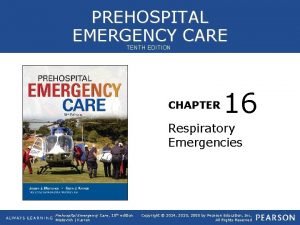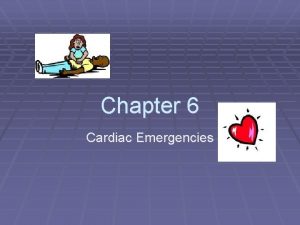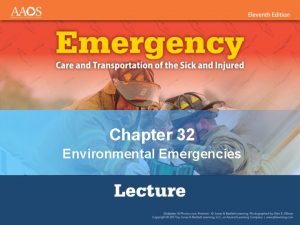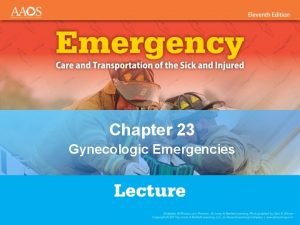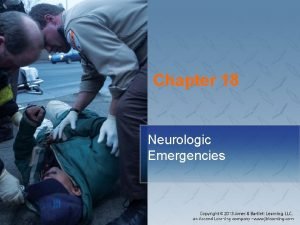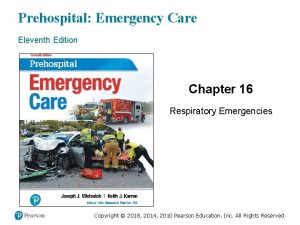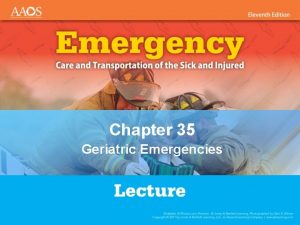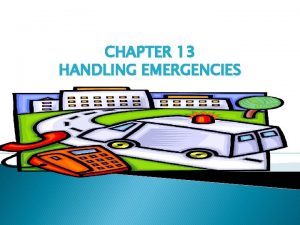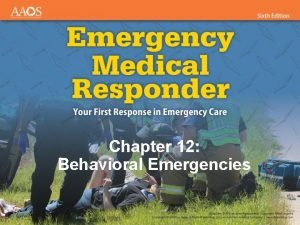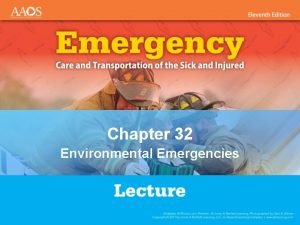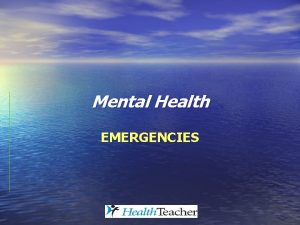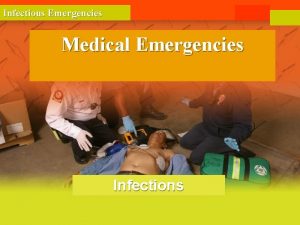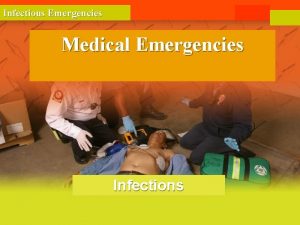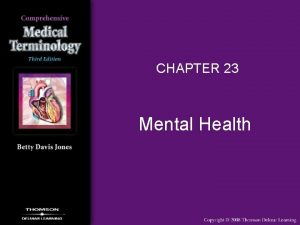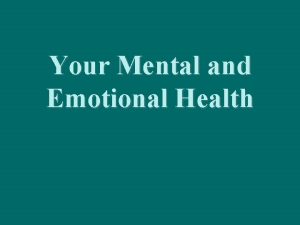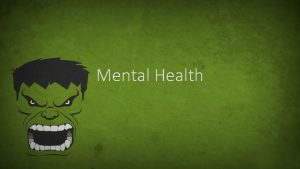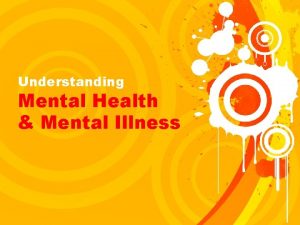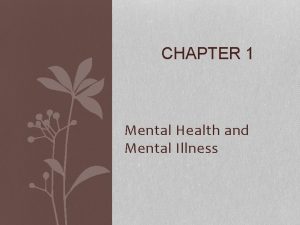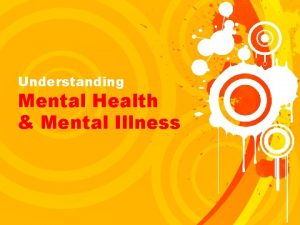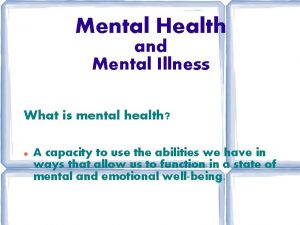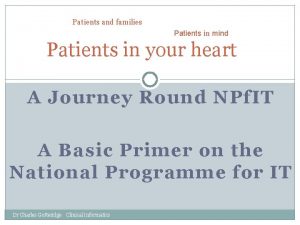Needs of Mental Health Patients During Emergencies During
























- Slides: 24

Needs of Mental Health Patients During Emergencies

During Any Disaster Impact Intensified By Pre-existing Conditions: • People with fewer economic resources • Living in lower cost, structurally vulnerable residences in higher risk areas • Cultural, racial and ethnic groups • Elderly on fixed income • Lack of home ownership or insurance • Single-parent • People with disabilities • Behavioral health issues

Types of Major Mental Illness • • Schizophrenia Schizoaffective disorder Bipolar Disorder Major Depression Panic and other Severe Anxiety Disorders Post Traumatic Stress Disorder Personality Disorder

Prevelance • U. S. Adults with a Mental Disorder in Any One Year • Type of Mental Disorder % Adults • � Anxiety disorder 18. 1 • � Major depressive disorder 6. 7 • � Substance use disorder 3. 8 • � Bipolar disorder 2. 6 • � Eating disorders 2. 1 • � Schizophrenia 1. 1 • Any mental disorder 26. 2

Facts about Mental Illness • Mental illnesses are biologically based brain disorders. They cannot be overcome through "will power" and are not related to a person's "character" or intelligence. • Mental disorders fall along a continuum of severity. The most serious and disabling conditions affect five to ten million adults (2. 6 – 5. 4%) and three to five million children ages five to seventeen (5 – 9%) in the United States. • Mental disorders are the leading cause of disability (lost years of productive life) in the North America, Europe and, increasingly, in the world. By 2020, Major Depressive illness will be the leading cause of disability in the world for women and children.

Dealing With Stress • Watch for signs of stress • Warning Signs of Stress – – – – 9/25/2020 Short tempers, frequent arguments Greater consumption of drugs or alcohol Smoking more than usual Getting upset over minor irritations Difficulty sleeping, bad dreams Aches, pains, stomach problems Loss of concentration Depression 6

Stress Reactions “Normal Reactions To Abnormal Events”

Normal Signs of Stress Behavioral – Hyperactive – Isolation / withdrawal – Don’t want to leave home – Aggressiveness – Hyper-vigilance – Increased drug/alcohol use 9/25/2020 8

Normal Signs of Stress Emotional • • 9/25/2020 Anger Hopeless Worry Depression Guilt Overwhelmed Numb 9

Normal Signs of Stress Physical Headaches Stomach problems Sleep problems Eating changes Health problems worsening – Fatigue / Exhaustion – Aggravation – New health problems – – – 9/25/2020 10

Normal Signs of Stress Cognitive Can’t cope Nightmares Difficulty concentrating Difficulty remembering Difficulty making decisions – Bad thoughts – – – 9/25/2020 11

Older Adults Common Reactions -Withdrawal / Isolation -Fear of loss of independence (fear of institutionalization) -Worsening of chronic health problems -Suspicion -Depression/Anxiety -Reluctant to leave home -Confusion -Inability to Concentrate -Difficulty Remembering -Nightmares 9/25/2020 Interventions -Provide assistance with recovery of possessions if possible -Provide strong and persistent verbal reassurance -Provide orienting information -Encourage discussion of disaster losses and expressions of emotions -Spend time with them- “show you care” -Recognize limitations -Sleep and Diet Control 12

Psychological Crisis • An acute response to a trauma, disaster, or other critical incident in which: – Psychological balance is disrupted – One’s usual coping mechanisms have failed – Evidence of significant distress, impairment, dysfunction

Mediating Factors • The victim’s prior experience with the same or a similar event. The emotional effect of multiple events can be cumulative, leading to greater stress reactions. • The intensity of the disruption in the survivors’ lives. The more the survivors’ lives are disrupted, the greater their psychological and physiological reactions may become. • The meaning of the event to the individual. The more catastrophic the victim perceives the event to be to him or her personally, the more intense will be his or her stress reaction. • The emotional well-being of the individual and the resources (especially social) that he or she has to cope. People who have had other recent traumas may not cope well with additional stressors. • The length of time that has elapsed between the event’s occurrence and the present. The reality of the event takes time to “sink in. ”

Stabilizing Individual The goal of psychological first aid is to stabilize the incident scene by stabilizing individuals. – Assess the disaster victims for injury and shock. – Provide support by: • Listening. • Empathizing. – Help disaster survivors connect with natural support systems.

DBHDID Behavioral Health Centers

6 Core Emergency Service Elements within the regional CMHC • 1 -800 Crisis and Information Lines • Mobile Crisis Services provide flexible crisis supports in a variety of settings (such as homes, emergency rooms, police stations, outpatient mental health settings, schools) and at flexible hours of the day. The purpose is to decrease the potential for more intensive services by providing more immediate community crisis services.

6 Emergency Service Elements • Crisis Stabilization Units (CSUs) are utilized when individuals in a behavioral health emergency cannot be safely accommodated within the community, but are not in need of hospitalization. The purpose is to stabilize the individual and re-integrate them back into the community in a timely fashion • Other Residential Overnight Crisis Services are offered as an alternative to a crisis stabilization unit. Beds are available in alternative settings, such as personal care homes, therapeutic foster care, or emergency apartments. These settings provide overnight, flexible, out-of-home care that is designed to meet the individual’s need.

6 Emergency Service Elements • 23 -hour Holding Beds - short, intensive treatment in a safe environment, in a less restrictive setting than hospitalization. This service element is appropriate when it is expected that the immediate crisis can be managed in less than 24 hours. Services may include medication management, collaborative team meetings, and referral services. • Transportation Services offer safe, timely and cost effective support to individuals in need of transportation to mental health services. This service is critical to an integrated emergency service array. The purpose is to decrease the need for more restrictive settings by providing the ability for individuals to maintain ongoing necessary mental health services.

Regional Availability of Emergency Services by Type • • • Crisis and Information Lines ~ 14 Regions Walk In Crisis (8 a-5 p) ~ 14 Regions Walk In Crisis (after hours) ~ 8 Regions Mobile Crisis Services ~ 8 Regions 1 -800 -Suicide Lines ~ 8 Regions Residential Crisis Units (A) ~ 11 Regions Residential Crisis Units (C ) ~ 9 Regions Overnight Crisis Beds (A) ~ 3 Regions Overnight Crisis Beds (C) 5 Regions

Watch out for “Burn-out” • This state of exhaustion, irritability and fatigue creeps up unrecognized and can markedly decrease the individual’s effectiveness and capability. • Peers are often a great support. 9/25/2020 21

Substance Abuse during disasters Due to the overwhelming experience of disasters survivors may be vulnerable to unhealthy coping strategies. Survivors may: • resume abusing substances 9/25/2020 22

Coping with Substance Abuse after a disaster • Regular attendance to Alcoholic Anonymous Meetings • Regular attendance to Narcotics Anonymous Meetings • Talk to a Professional • Seek Professional Mental Health Counseling • Talk to your sponsor 9/25/2020 23

Contact Information Janine Dewey MA, CADC 100 Fair Oaks Lane 4 E-D Frankfort, KY 40621 502 -564 -4456 Ext. 4520
 Hierarchy of emotions
Hierarchy of emotions Mental health and mental illness chapter 20
Mental health and mental illness chapter 20 Stress management jeopardy
Stress management jeopardy Primary needs and secondary needs
Primary needs and secondary needs Primary needs and secondary needs
Primary needs and secondary needs Alpha press murray
Alpha press murray Strategic gender needs and practical gender needs
Strategic gender needs and practical gender needs What is target needs
What is target needs Padi quiz 3 answers
Padi quiz 3 answers Chapter 16 respiratory emergencies
Chapter 16 respiratory emergencies Major nutritional deficiency diseases in emergencies
Major nutritional deficiency diseases in emergencies Lesson 6: cardiac emergencies and using an aed
Lesson 6: cardiac emergencies and using an aed Environmental emergencies emt
Environmental emergencies emt Chapter 23 gynecologic emergencies
Chapter 23 gynecologic emergencies During a psychiatric emergency the emt should be able to
During a psychiatric emergency the emt should be able to Chapter 19 endocrine and hematologic emergencies
Chapter 19 endocrine and hematologic emergencies Chapter 18 neurologic emergencies
Chapter 18 neurologic emergencies Emt chapter 18 gastrointestinal and urologic emergencies
Emt chapter 18 gastrointestinal and urologic emergencies Chapter 28 first aid and emergencies
Chapter 28 first aid and emergencies Chapter 16 respiratory emergencies
Chapter 16 respiratory emergencies Pumberton sign
Pumberton sign Gems diamond geriatric
Gems diamond geriatric Chapter 13 handling emergencies
Chapter 13 handling emergencies Chapter 12 behavioral emergencies
Chapter 12 behavioral emergencies Chapter 32 environmental emergencies
Chapter 32 environmental emergencies









